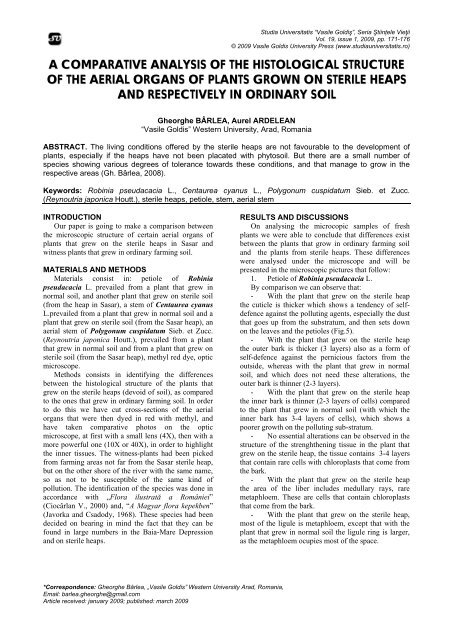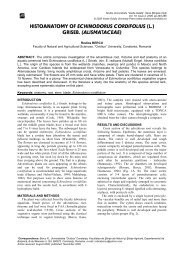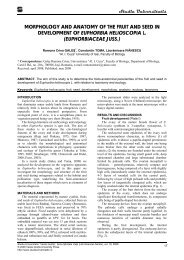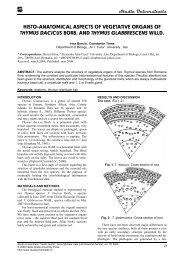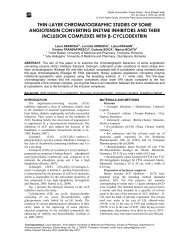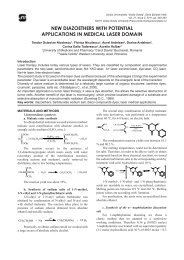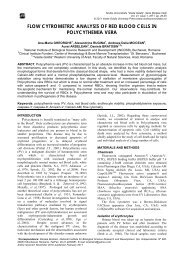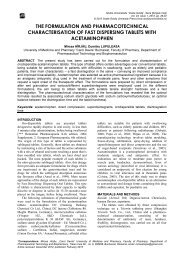Read full article - Studia Universitatis Vasile Goldis, Seria Stiintele ...
Read full article - Studia Universitatis Vasile Goldis, Seria Stiintele ...
Read full article - Studia Universitatis Vasile Goldis, Seria Stiintele ...
Create successful ePaper yourself
Turn your PDF publications into a flip-book with our unique Google optimized e-Paper software.
<strong>Studia</strong> <strong>Universitatis</strong> “<strong>Vasile</strong> Goldiş”, <strong>Seria</strong> Ştiințele Vieţii<br />
Vol. 19, issue 1, 2009, pp. 171-176<br />
© 2009 <strong>Vasile</strong> <strong>Goldis</strong> University Press (www.studiauniversitatis.ro)<br />
A COMPARATIVE ANALYSIS OF THE HISTOLOGICAL STRUCTURE<br />
OF THE AERIAL ORGANS OF PLANTS GROWN ON STERILE HEAPS<br />
AND RESPECTIVELY IN ORDINARY SOIL<br />
Gheorghe BÂRLEA, Aurel ARDELEAN<br />
“<strong>Vasile</strong> <strong>Goldis</strong>” Western University, Arad, Romania<br />
ABSTRACT. The living conditions offered by the sterile heaps are not favourable to the development of<br />
plants, especially if the heaps have not been placated with phytosoil. But there are a small number of<br />
species showing various degrees of tolerance towards these conditions, and that manage to grow in the<br />
respective areas (Gh. Bârlea, 2008).<br />
Keywords: Robinia pseudacacia L., Centaurea cyanus L., Polygonum cuspidatum Sieb. et Zucc.<br />
(Reynoutria japonica Houtt.), sterile heaps, petiole, stem, aerial stem<br />
INTRODUCTION<br />
Our paper is going to make a comparison between<br />
the microscopic structure of certain aerial organs of<br />
plants that grew on the sterile heaps in Sasar and<br />
witness plants that grew in ordinary farming soil.<br />
MATERIALS AND METHODS<br />
Materials consist in: petiole of Robinia<br />
pseudacacia L. prevailed from a plant that grew in<br />
normal soil, and another plant that grew on sterile soil<br />
(from the heap in Sasar), a stem of Centaurea cyanus<br />
L.prevailed from a plant that grew in normal soil and a<br />
plant that grew on sterile soil (from the Sasar heap), an<br />
aerial stem of Polygonum cuspidatum Sieb. et Zucc.<br />
(Reynoutria japonica Houtt.), prevailed from a plant<br />
that grew in normal soil and from a plant that grew on<br />
sterile soil (from the Sasar heap), methyl red dye, optic<br />
microscope.<br />
Methods consists in identifying the differences<br />
between the histological structure of the plants that<br />
grew on the sterile heaps (devoid of soil), as compared<br />
to the ones that grew in ordinary farming soil. In order<br />
to do this we have cut cross-sections of the aerial<br />
organs that were then dyed in red with methyl, and<br />
have taken comparative photos on the optic<br />
microscope, at first with a small lens (4X), then with a<br />
more powerful one (10X or 40X), in order to highlight<br />
the inner tissues. The witness-plants had been picked<br />
from farming areas not far from the Sasar sterile heap,<br />
but on the other shore of the river with the same name,<br />
so as not to be susceptible of the same kind of<br />
pollution. The identification of the species was done in<br />
accordance with „Flora ilustrată a României”<br />
(Ciocârlan V., 2000) and, “A Magyar flora kepekben”<br />
(Javorka and Csadody, 1968). These species had been<br />
decided on bearing in mind the fact that they can be<br />
found in large numbers in the Baia-Mare Depression<br />
and on sterile heaps.<br />
RESULTS AND DISCUSSIONS<br />
On analysing the microcopic samples of fresh<br />
plants we were able to conclude that differences exist<br />
between the plants that grow in ordinary farming soil<br />
and the plants from sterile heaps. These differences<br />
were analysed under the microscope and will be<br />
presented in the microscopic pictures that follow:<br />
1. Petiole of Robinia pseudacacia L.<br />
By comparison we can observe that:<br />
- With the plant that grew on the sterile heap<br />
the cuticle is thicker which shows a tendency of selfdefence<br />
against the polluting agents, especially the dust<br />
that goes up from the substratum, and then sets down<br />
on the leaves and the petioles (Fig.5).<br />
- With the plant that grew on the sterile heap<br />
the outer bark is thicker (3 layers) also as a form of<br />
self-defence against the pernicious factors from the<br />
outside, whereas with the plant that grew in normal<br />
soil, and which does not need these alterations, the<br />
outer bark is thinner (2-3 layers).<br />
- With the plant that grew on the sterile heap<br />
the inner bark is thinner (2-3 layers of cells) compared<br />
to the plant that grew in normal soil (with which the<br />
inner bark has 3-4 layers of cells), which shows a<br />
poorer growth on the polluting sub-stratum.<br />
- No essential alterations can be observed in the<br />
structure of the strenghthening tissue in the plant that<br />
grew on the sterile heap, the tissue contains 3-4 layers<br />
that contain rare cells with chloroplasts that come from<br />
the bark.<br />
- With the plant that grew on the sterile heap<br />
the area of the liber includes medullary rays, rare<br />
metaphloem. These are cells that contain chloroplasts<br />
that come from the bark.<br />
- With the plant that grew on the sterile heap,<br />
most of the ligule is metaphloem, except that with the<br />
plant that grew in normal soil the ligule ring is larger,<br />
as the metaphloem ocupies most of the space.<br />
*Correspondence: Gheorghe Bârlea, „<strong>Vasile</strong> <strong>Goldis</strong>” Western University Arad, Romania,<br />
Email: barlea.gheorghe@gmail.com<br />
Article received: january 2009; published: march 2009
Bârlea Gh., Ardelean A.<br />
Fig. 1 Cross section in the petiole of Robinia pseudacacia<br />
L. A plant that grew in normal soil, x 10<br />
Fig. 2 Cross section in the petiole of Robinia pseudacacia<br />
L. A plant that grew on sterile substratum, x 10<br />
Fig. 3 Cross section in the petiole of Robinia pseudacacia<br />
L., a plant that grew in normal soil. Detail, x 40<br />
Fig. 4 Cross section in the petiole of Robinia pseudacacia<br />
L., a plant that grew on sterile substratum. Detail, x 40<br />
Fig. 5 Polluting dust set down on the leaves of Robinia<br />
pseudacacia L. on the Săsar sterile heap<br />
Fig. 6 Cross-section in a stem of Centaurea cyanus L., a<br />
plant that grew in normal soil, x 10<br />
- With the plant that grew on the sterile heap,<br />
the ligule is not so well developed, probably because of<br />
the pollutant agents that hinder the normal growth of<br />
the tissues.<br />
172<br />
- With the plant that grew on the sterile heap<br />
there are no substantial alterations of the medulla and<br />
the cambium, which look normal both in the plant that<br />
grew on the sterile heap and the one that grew in<br />
<strong>Studia</strong> <strong>Universitatis</strong> “<strong>Vasile</strong> Goldiş”, <strong>Seria</strong> Ştiințele Vieţii<br />
Vol. 19, issue 1, 2009, pp. 171-176<br />
© 2009 <strong>Vasile</strong> <strong>Goldis</strong> University Press (www.studiauniversitatis.ro)
A comparative analysis of the histological structure of the aerial organs<br />
of plants grown on sterile heaps and respectively in ordinary soil<br />
normal soil, although the sclerenchyma, the<br />
collenchyma, and the liber tissue seem less developed.<br />
2. A stem of Centaurea cyanus L.<br />
The Centaurea genus is well represented on the<br />
sterile heaps, especially on the one from Sasar, not so<br />
much in the number of species, but mainly in the<br />
number of plants and the area on which they grow.<br />
This is the reason why I have decided to have<br />
microscopic samples of the stem, and to compare them<br />
with plants that grow in normal soil. Thus, one can<br />
observe that the plants from this species as well as<br />
other species that grow on the sterile, show a higher<br />
degree of weathering and ageing than the plants that<br />
grow in normal soil. Thus, at the level of the stem we<br />
can observe in the cross-section that:<br />
- With the plant that grew on the sterile heap<br />
the epiderm is badly exfoliated compared to the plant<br />
from the normal soil, which shows a higher degree of<br />
weathering, a thing which can be seen with the naked<br />
eye through macroscopic analysis. This exfoliation<br />
may be due to the anorganic dust which causes the<br />
dehydration of the cells leading to the detaching of<br />
some of them and thus creating flaws.<br />
- With the plant that grew on the sterile heap<br />
the outer bark is also more exfoliated than with the one<br />
that grew in normal soil (which also has 3-4 layers of<br />
cells), thus continuing the process started in the<br />
epiderm.<br />
- With the plant that grew on the sterile heap<br />
the inner bark shows no flaws, but shows a slight<br />
tendency towards growing thinner (2-3 layers)<br />
compared to the plant that grew in normal soil (3-4<br />
layers) most probably as a manifestation of the lack of<br />
the nourishing substances that the sterile soil has not<br />
been able to offer.<br />
- With the plant that grew on the sterile heap<br />
the medullary rays are narrower compared to the plant<br />
that grew in normal farming soil with which the rays<br />
are normal up to the bark.<br />
- With the plant that grew on the sterile heap<br />
the ligule (which contains more metaxylem) and the<br />
liber are narrower than normal, having denser fascicles,<br />
although it shows no other visible alterations, but the<br />
majority of tissues show the same direction determined<br />
by the scarcity of nourishing substances, which the<br />
sterile heap is incapable of ensuring if there is no<br />
adequate phyto-soil placating. In the witness plant, the<br />
ligule has metaxylem at the inside and protoxylem at<br />
the outside, the liber representing one third of the ligule<br />
thickness.<br />
- With the plant that grew on the sterile heap as<br />
a reaction of defence against pollutant factors, and the<br />
poor nourishing conditions, the strenghthening tissue<br />
has a tendency of growth (being almost uninterrupted<br />
except for some very thin medullary rays) taking up<br />
some of the space of the medullary rays,too, a<br />
manifestation which can be observed in many other<br />
plants that grow in a polluted environment. With the<br />
witness plant, the strenghthening tissue is continual,set<br />
among the perixyl.<br />
- With the plant that grew on the sterile heap<br />
the medulla is normal, but has smaller cells than the<br />
witness plant.<br />
3. Aerial stem of Polygonum cuspidatum Sieb. et<br />
Zucc. (Reynoutria japonica Houtt.).<br />
The aerial stem of Polygonum cuspidatum Sieb. et<br />
Zucc. (Reynoutria japonica Houtt.) is at least similar at<br />
the plant from the sterile soil to the plant grown in<br />
normal soil. Thus:<br />
- With the plant that grew on the sterile heap,<br />
(Fig. 11), the cuticle is somehow thicker than with the<br />
plant grown in normal soil (fig. 12), against the<br />
background of the perrenial self-defence against an<br />
aggressive environment.<br />
- With the plant that grew on the sterile heap<br />
the bark has several chloroplasts, 7-8 layers of cells<br />
similar to the one from the witness plant, showing no<br />
clear decelable microscopic alterations,except for the<br />
fact that it is thinner.<br />
- With the plant that grew on the sterile heap<br />
the strenghthening tissue is better developed and more<br />
continual, rarely interrupted by medullary rays, against<br />
the same tendency of defence against the environment<br />
factors, whereas with the witness plant it is<br />
discontinual due to the perixyls (Fig.10).<br />
- With the plant that grew on the sterile heap,<br />
the liber is more clearly fragmented than with the plant<br />
from the normal soil, a character which we have<br />
generally encountered at the plants from sterile soils,<br />
probably because of a sudden dehydration due to the<br />
loss of water at the level of the sterile substratum on<br />
the hill side.<br />
- With the plant that grew on the sterile heap,<br />
the ligule contains less metaxylem, that is the ducts<br />
have not been able to grow to this stage, probably<br />
because of the lack of nutrients, besides the ample<br />
dehydration, whereas with the witness plant the ligulw<br />
has less than 20 % very compact metaxylem.<br />
- With the plant that grew on the sterile heap<br />
the medullary rays are unaltered compared to normal<br />
(Fig.9), being clear, up to the strenghthening tissue.<br />
With the plant that grew on the sterile heap the<br />
medulla has somewhat smaller cells than the normal<br />
plant, but no major differences are evident, except that<br />
the cells are larger in the centre, with fewer<br />
amyloplasts, the cells being smaller at the exterior and<br />
having more amyloplasts.<br />
<strong>Studia</strong> <strong>Universitatis</strong> “<strong>Vasile</strong> Goldiş”, <strong>Seria</strong> Ştiințele Vieţii<br />
Vol. 19, issue 1, 2009, pp. 171-176<br />
© 2009 <strong>Vasile</strong> <strong>Goldis</strong> University Press (www.studiauniversitatis.ro)<br />
173
Bârlea Gh., Ardelean A.<br />
Fig. 7 Cross-section in a stem of Centaurea cyanus L., a<br />
plant that grew on sterile soil, x 10<br />
Fig. 8 Cross-section in a stem of Centaurea cyanus L., a<br />
plant that grew in normal soil. Detail, x 40<br />
Fig. 9 Cross section in aerial stem of Polygonum<br />
cuspidatum Sieb. et Zucc. (Reynoutria japonica Houtt.). A<br />
plant that grew in normal soil, x 10<br />
Fig. 10 Cross section in aerial stem of Polygonum<br />
cuspidatum Sieb. et Zucc. (Reynoutria japonica Houtt.).<br />
Plant grown in normal soil, x 10<br />
Fig. 11 Cross section in aerial stem of Polygonum<br />
cuspidatum Sieb. et Zucc. (Reynoutria japonica Houtt.).<br />
Plant grown in normal soil, x 10<br />
Fig. 12 Cross section in aerial stem of Polygonum<br />
cuspidatum Sieb. et Zucc. (Reynoutria japonica Houtt.).<br />
Plant grown on sterile soil x 10<br />
174<br />
<strong>Studia</strong> <strong>Universitatis</strong> “<strong>Vasile</strong> Goldiş”, <strong>Seria</strong> Ştiințele Vieţii<br />
Vol. 19, issue 1, 2009, pp. 171-176<br />
© 2009 <strong>Vasile</strong> <strong>Goldis</strong> University Press (www.studiauniversitatis.ro)
A comparative analysis of the histological structure of the aerial organs<br />
of plants grown on sterile heaps and respectively in ordinary soil<br />
Fig. 13 Plantlet of dried out Robinia pseudacacia L. on<br />
the southern side of the Săsar sterile heap<br />
CONCLUSIONS<br />
Considering the things we have presented above,<br />
we can say that:<br />
1. Robinia pseudacacia L., is a very resistant<br />
species to the environment factors, including the ones<br />
from the sterile heaps. There exist certain alterations on<br />
the sterile substratum, however they are not very<br />
ample, and above all not significant enough to prevent<br />
the species to grow in these areas. The acumulation of<br />
pollutants in this plant does, of course, hinder its<br />
development, however,even if its size and even its<br />
vigour are smaller than in normal substratum, this<br />
species qualifies itself very well for becoming an<br />
important element in the settling of the ground and<br />
regenerating of the soil on the sterile heaps, especially<br />
after it has been placated with phyto-soil.<br />
Of course, as one can see, Robinia pseudacacia L<br />
is sensitive to certain conditions. Thus, when planted<br />
on the southern side of the hill, in <strong>full</strong> sun, and on a<br />
steep slope, which does not retain water, the plants<br />
went dry pretty soon (Fig.13); but when planted on the<br />
northern or western side, or on less steep slopes, which<br />
retain more water (although the sterile maintains a high<br />
degree of moist), this plant grew very well, rooted<br />
well-enough not to be blown down by the wind, grew<br />
enough foliage, which through putrefaction contributed<br />
to the forming of soil,be that rather slowly, indeed.<br />
The species is present on all the sterile heaps in the<br />
Baia-Mare Depression (including the one in Bozânta),<br />
growing better when planted in areas with more moist<br />
and slopes not too steep, and with less exposure to the<br />
sun. This plant can reach in such areas a good<br />
development (even for normal soils), such as the northwestern<br />
side of the sterile heap in Sasar, but its use as<br />
melliferous plant is very limited, even negligible in<br />
droughty conditions, because of the polluting dust<br />
which sets down on the leaves (Fig.5), and which sends<br />
away the bees or even kills them if the dust sets on the<br />
flowers during a droughty period when the plants are<br />
blooming. Rain may wash away at least some of the<br />
dust, even to the point at which the bees can work.<br />
<strong>Studia</strong> <strong>Universitatis</strong> “<strong>Vasile</strong> Goldiş”, <strong>Seria</strong> Ştiințele Vieţii<br />
Vol. 19, issue 1, 2009, pp. 171-176<br />
© 2009 <strong>Vasile</strong> <strong>Goldis</strong> University Press (www.studiauniversitatis.ro)<br />
These are the main reasons why all the sterile heaps, at<br />
least in the Bia-Mare Depression have Robinia<br />
pseudacacia L., as main arboricolous fixing element.<br />
Even though on smaller areas can be seen Populus<br />
alba L., Populus nigra L., Populus tremula L.,<br />
Quercus petraea (Mattuschka) Liebl., Quercus robur<br />
L., and even Castanea sativa Miller (Castanea vesca<br />
Gärtn.), the acacia remains by far the most widespread,<br />
and the most constant plant on the sterile heaps.<br />
To conclude with, Robinia pseudacacia L. is a<br />
species which, even though on the sterile heaps has a<br />
growth which is hindered, as compared to normal, this<br />
plant easily adapts itself to settle and regenerate the soil<br />
on the sterile heaps, the histological alterations being<br />
insignificant for the development of the plants.<br />
2. The Centaurea genus is well-represented on the<br />
sterile heaps (especially on the one in Săsar), but has a<br />
low degree of coverage due to the rare distribution of<br />
the plants. Centaurea cyanus L. is a species which, as<br />
we have shown above is not greatly affected by the<br />
sterile substratum, but then, it can neither be<br />
considered essential for the forming of soil directly on<br />
the sterile, at least because of its reduced density.<br />
However, after a previous placating of the heaps with<br />
phyto-soil in a thin layer, Centaurea cyanus L. might<br />
help a lot to cut down on the cost of ecologising, as it is<br />
a true settler of soil, at least till the natural development<br />
of other species of plants.<br />
3. Out all the species dealt with in this paper,<br />
Polygonum cuspidatum Sieb. et Zucc. (Reynoutria<br />
japonica Houtt.) is the one that is least affected by<br />
what kind of sterile substratum it grows on, and this is<br />
why it may be considered as a pioneer of vegetal<br />
expansion on the sterile heaps, and mainly in the<br />
farming fields in the area. Although the species is<br />
recognised as being spread at the level of Romania<br />
mainly in Maramures (V. Ciocârlan, 2000), it grows on<br />
the sands in the north-west of the country (G. Ardelean,<br />
C. Karácsonyi, 2005), up to the Ieru valley (G.<br />
Ardelean, C. Karácsonyi, 2002), but cannot be found<br />
south of the Bihor County (A. Ardelean, 2006). This<br />
plant was initially cultivated to be eaten and as<br />
ornament, but it spread and grew wild, covering larger<br />
and larger expanses of land, without the intervention of<br />
man, who tried then to reduce its expansion because it<br />
was threatening the cultivated plants. Polygonum<br />
cuspidatum Sieb. et Zucc. (Reynoutria japonica<br />
Houtt.) can be grown either after rooting, or directly as<br />
cuttings, even in sterile substratum, but, if only a very<br />
thin layer of soil is used, through its rich network of<br />
roots, it fixes the soil very well, and the rich foliage<br />
consistently contributes to the generating of new soil.<br />
Taking into account everything we have stated above,<br />
we can conclude that Polygonum cuspidatum Sieb. et<br />
Zucc. (Reynoutria japonica Houtt.) is a species that<br />
might become one of the biological materials that can<br />
be used for settling and ecologising the sterile heaps.<br />
175
Bârlea Gh., Ardelean A.<br />
REFERENCES<br />
Ardelean A., 2006, Flora şi Vegetaţia Judeţului Arad,<br />
Editura Academiei Române Bucureşti.<br />
Ardelean G., Karácsonyi C., 2002, Flora şi fauna Văii<br />
Ierului, Editura Bion, Satu Mare.<br />
Ardelean G., Karácsonyi C., 2005, Flora, vegetaţia,<br />
fauna şi ecologia nisipurilor din nord-vestul<br />
României, Ed.Daya, Satu Mare<br />
Bârlea Gh., 2008, A study on barren gangues in the<br />
Baia Mare Depression, “V. Goldiş” University<br />
Press Arad.<br />
Ciocârlan V., 2000, Flora ilustrată a României, Editura<br />
Ceres.<br />
Javorka S., Csadody Vera, 1968, A Magyar flora<br />
kepekben, Ed. Studium, Budapest.<br />
Nădişan I., 1979, Implicaţiile poluării asupra vegetaţiei<br />
din zona Municipiului Baia Mare, Baia Mare.<br />
176<br />
<strong>Studia</strong> <strong>Universitatis</strong> “<strong>Vasile</strong> Goldiş”, <strong>Seria</strong> Ştiințele Vieţii<br />
Vol. 19, issue 1, 2009, pp. 171-176<br />
© 2009 <strong>Vasile</strong> <strong>Goldis</strong> University Press (www.studiauniversitatis.ro)


